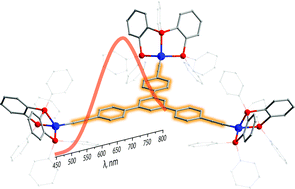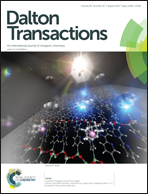Alkynyl triphosphine copper complexes: synthesis and photophysical studies†
Abstract
A rigid triphosphine PPh2C6H4–PPh–C6H4PPh2 (P3) reacted with Cu+ and a stoichiometric amount of terminal alkyne under basic conditions to give a family of copper(I) alkynyl compounds [Cu(P3)C![[triple bond, length as m-dash]](https://www.rsc.org/images/entities/char_e002.gif) CR]. The number of terminal –C
CR]. The number of terminal –C![[triple bond, length as m-dash]](https://www.rsc.org/images/entities/char_e002.gif) CH groups in the starting ligand determines the nuclearity of the resulting complexes giving mono- (1, R = Ph; 2, R = C6H4OMe; 3, R = C6H4NO2; 4, R = C6H4CF3; 5, R = 2-pyridyl), di- (R = -(C6H4)n-, n = 1 (6), n = 2, (7), n = 3 (2)) and trinuclear complexes (9, R = 1,3,5-(C6H4)3-C6H3; 10, R = 1,3,5-(C6H4-4-C2C6H4)3-C6H3). In all the complexes the Cu(I) centers are found in a distorted tetrahedral environment that is achieved by tridentate coordination of the P3 ligand and σ-bonding to the alkynyl function. The crystal structures of 1, 3 and 5 were estimated by single crystal X-ray diffraction analysis. The 31P, 1H and 1H–1H COSY NMR spectroscopy confirms that all the molecules remain intact in solution. The photophysical studies carried out in the solid state at 298 and 77 K revealed moderate to weak orange luminescence (Φem up to 19%), tentatively assigned to thermally activated delayed fluorescence for the mononuclear complexes. The quantum yields of emission of 1–10 demonstrated strong dependence on the nature of the alkynyl ligand, the role of which in the electronic transitions was elucidated by TD-DFT computational studies.
CH groups in the starting ligand determines the nuclearity of the resulting complexes giving mono- (1, R = Ph; 2, R = C6H4OMe; 3, R = C6H4NO2; 4, R = C6H4CF3; 5, R = 2-pyridyl), di- (R = -(C6H4)n-, n = 1 (6), n = 2, (7), n = 3 (2)) and trinuclear complexes (9, R = 1,3,5-(C6H4)3-C6H3; 10, R = 1,3,5-(C6H4-4-C2C6H4)3-C6H3). In all the complexes the Cu(I) centers are found in a distorted tetrahedral environment that is achieved by tridentate coordination of the P3 ligand and σ-bonding to the alkynyl function. The crystal structures of 1, 3 and 5 were estimated by single crystal X-ray diffraction analysis. The 31P, 1H and 1H–1H COSY NMR spectroscopy confirms that all the molecules remain intact in solution. The photophysical studies carried out in the solid state at 298 and 77 K revealed moderate to weak orange luminescence (Φem up to 19%), tentatively assigned to thermally activated delayed fluorescence for the mononuclear complexes. The quantum yields of emission of 1–10 demonstrated strong dependence on the nature of the alkynyl ligand, the role of which in the electronic transitions was elucidated by TD-DFT computational studies.


 Please wait while we load your content...
Please wait while we load your content...